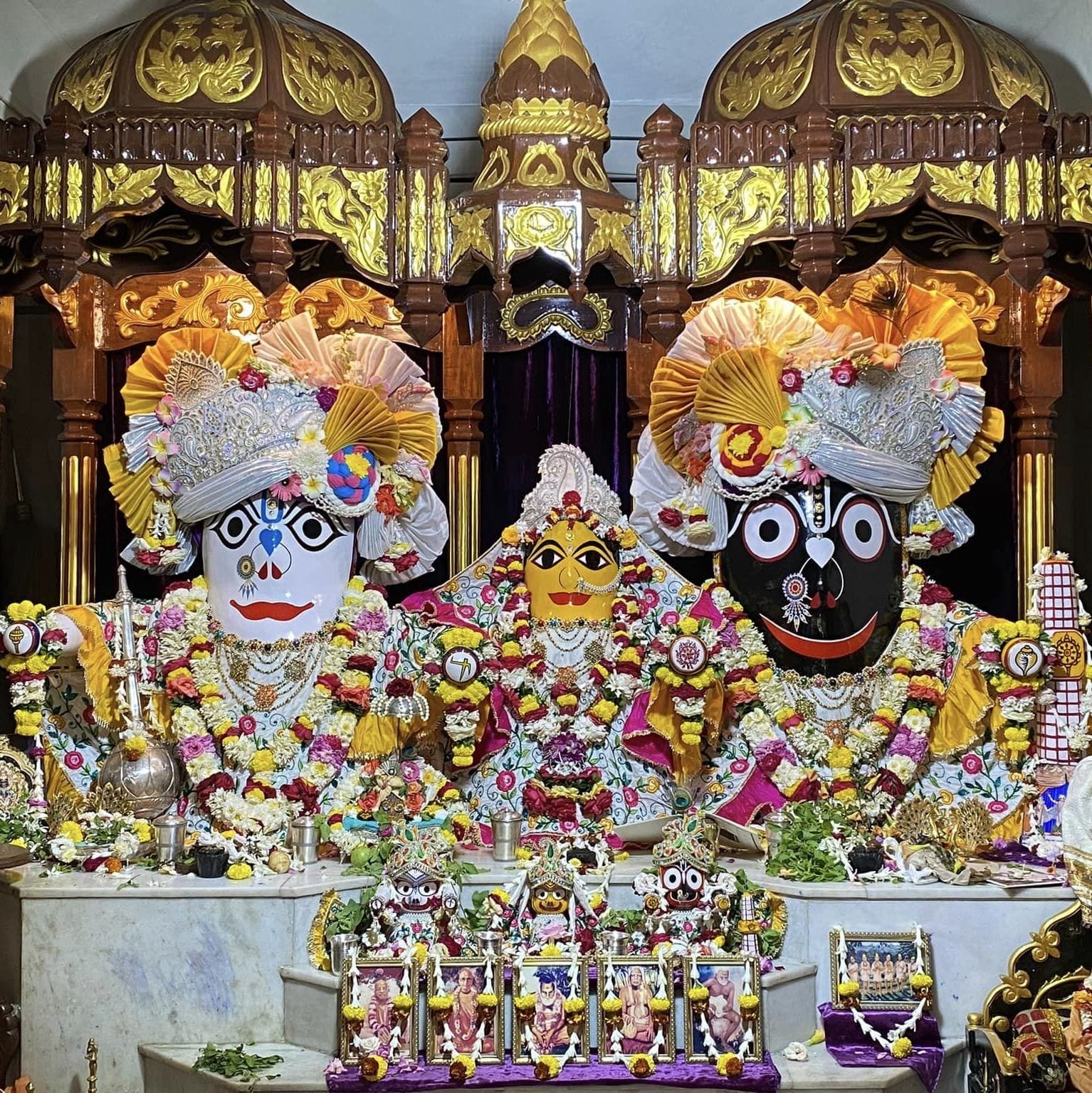
Jagannath Baladeva Subhadra devi
jagannātha-svāmī nayana-patha-gāmī bhavatu me
“O Lord of the universe, please be visible unto me.”
Overwhelmed with love, Nityananda then quickly moved on to Sankhavanik-nagara, where He spoke to Jiva, “Saraḍāngā is a wonderful sight. Even the name is most enchanting. Jagannatha resides here with the sabaras. When the demon Raktabāhu created disturbances, the Lord came here with His dayitā (beloved). Know for certain that this place is nondifferent from Jagannātha Puri, for Lord Jagannātha is eternally situated here.”
(Sri Navadvipa-Dhama-Mahatmya, Chapter 6)
Lord Jagannātha is the Supreme Lord Himself in the form of wood, and the river Ganges is the Supreme Lord Himself in the form of water.
(CC Madhya 15.135)
Jagat means moving. And Jagat-nātha, nātha means the proprietor—master, proprietor. So Jagannātha means the proprietor or the master of all these movements, He is Jagannātha. And Balabhadra, Balarāma, bala means strength, and rāma means enjoyment. So Balarāma means who gives you spiritual strength for enjoying eternal blissful life. He is Balarāma. And Subhadrā, su means auspicious, and bhadra means well-being. Subhadrā, Jagannātha and Balarāma combined together are present before you to reclaim you all from your miserable condition of life. That is the purport of this Ratha-yātrā Festival. Ratha-yā . . . (break) . . . if anyone sees on the car Jagannātha, Subhadrā and Baladeva, then he does not take birth again in this material world. Ratheja vamanaṁ dṛṣṭa.
(700705 – Lecture Festival Ratha-yatra – San Francisco)
Lord Jagannātha is the Supreme Personality of Godhead. He possesses all potencies. Therefore He is able to act freely and can do and undo whatever He likes.
(CC Antya 9.44)
Subhadrā: Daughter of Vasudeva and sister of Lord Śrī Kṛṣṇa. She was not only a very dear daughter of Vasudeva, but also a very dear sister to both Kṛṣṇa and Baladeva. The two brothers and sister are represented in the famous Jagannātha temple of Purī, and the temple is still visited by thousands of pilgrims daily.
(SB 1.13.3-4)
For further reading, please refer to:
Srila Prabhupada Lecture Festival after Ratha-yatra – London – 16 July 1972
Srila Prabhupada Lecture Festival Ratha-yatra – San Francisco – 5 July 1970
It has been described in Navadvipa-dhama Mahatmya that many ages ago, Lord Jagannath was brought to Bengal by His Savara devotees because they were afraid of a ferocious demon named Raktabahu. In Simantadvipa, one of the nine islands of Navadvipa, they then installed the Lord at this very spot. Since that time, this place has been considered non-different from Jagannath Puri itself. The Savara devotees, having served Lord Jagannath for a very long time, disappeared from this earth and attained the transcendental abode of the Lord by dint of their pure devotion. Thus, without those devotees to perform the worship, the services to the deity stopped. By the influence of time, the deity, along with the temple, vanished from sight. However, desiring to remain in this place, Lord Jagannath continued to stay here in a concealed form.
Later, when the Lord was performing pastimes on this planet as Sri Chaitanya Mahaprabhu, He gave mercy to one devotee named Sri Jagadish Ganguly by revealing His form as Lord Jagannath again. In more recent times, a devoted Brahmin named Sri Phatik Chandra Chatterjee had the opportunity to render service to the Lord by worshipping Him for many years. When he became too old to carry out his duties, he was inspired by Lord Jagannath Himself to hand over the Lord’s service and worship to the devotees of ISKCON in the year 1979. In 1985, Lord Jagannath, along with His brother Lord Balaram and sister Subhadra, entered this new temple built by the disciples and grand-disciples of His Divine Grace A.C. Bhaktivedanta Swami Prabhupada.
(Inscription on Temple Walls)
Renovation of this Temple was completed in May 2004.
